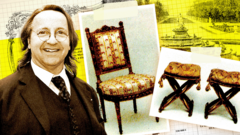This incident highlights the fragility of trust in antique valuation, and the need for more stringent oversight in art markets.
**Furniture Fraud Scandal Rocks French Antiques Market**

**Furniture Fraud Scandal Rocks French Antiques Market**
The deception involving fake royal chairs has raised serious questions about authenticity and accountability in the art world.
In the early 2010s, the appearance of two ornate chairs allegedly belonging to Marie Antoinette on the French antiques market marked what seemed to be a remarkable discovery. These chairs, thought to be the work of the renowned 18th-century carpenter Nicolas-Quinibert Foliot, were quickly recognized as "national treasures" by the French government in 2013 at the request of the Palace of Versailles, which later expressed interest in purchasing them. However, the hefty price tag of €2 million (£1.67 million) deterred the palace, leading to their sale to Qatari Prince Mohammed bin Hamad Al Thani instead.
Alongside these chairs were several other pieces implicated in a growing collective of so-called royal furniture that had emerged in recent years. Other items included those claimed to have belonged to notable figures such as Madame du Barry and Princess Élisabeth. Many of these pieces were acquired by Versailles for its museum collection, while others found homes with wealthy collectors.
However, this extravagant tale took a dark turn in 2016 when it was revealed that all the chairs, alongside other celebrated pieces, were forgeries. Their discovery sparked a scandal that sent shockwaves through the French antiques community and led to significant legal repercussions. Notably, renowned antiques expert Georges "Bill" Pallot and accomplished cabinetmaker Bruno Desnoues faced trial on charges of fraud and money laundering following an exhaustive nine-year investigation.
Serving as a central figure in this case, Pallot was often called upon to authenticate historical items and had even assisted Versailles in identifying missing furniture from its archives. The duo's venture reportedly began as a simple test of their craftsmanship in 2007. Yet as they successfully replicated period furniture, their initial mischief morphed into a lucrative scheme, producing numerous fake pieces that made their way through established middlemen and galleries to auction houses.
Prosecutors allege that the pair amassed an estimated profit exceeding €3 million through their fraudulent activities. The charges were bolstered by revelations regarding how Pallot’s esteemed academic background allowed him to exploit the trust institutions like Versailles placed in him.
In light of these developments, charges of "gross negligence" were also directed at Laurent Kraemer, director of Galerie Kraemer, along with the gallery itself, for allegedly failing to adequately verify the authenticity of items before reselling. Representatives for Kraemer’s gallery vehemently deny any complicity, presenting themselves as victims of deceit rather than accomplices.
The scandal opened doors to a broader discourse on the dire need for enhanced regulations within the art market, emphasizing the importance of credibility and due diligence in transactions involving high-value artifacts. As the implications of this case reverberate through artistic and collector communities alike, the fallout underscores that even the most prestigious institutions can be vulnerable to deception, calling for an introspective look at practices within the antiques sector.
Alongside these chairs were several other pieces implicated in a growing collective of so-called royal furniture that had emerged in recent years. Other items included those claimed to have belonged to notable figures such as Madame du Barry and Princess Élisabeth. Many of these pieces were acquired by Versailles for its museum collection, while others found homes with wealthy collectors.
However, this extravagant tale took a dark turn in 2016 when it was revealed that all the chairs, alongside other celebrated pieces, were forgeries. Their discovery sparked a scandal that sent shockwaves through the French antiques community and led to significant legal repercussions. Notably, renowned antiques expert Georges "Bill" Pallot and accomplished cabinetmaker Bruno Desnoues faced trial on charges of fraud and money laundering following an exhaustive nine-year investigation.
Serving as a central figure in this case, Pallot was often called upon to authenticate historical items and had even assisted Versailles in identifying missing furniture from its archives. The duo's venture reportedly began as a simple test of their craftsmanship in 2007. Yet as they successfully replicated period furniture, their initial mischief morphed into a lucrative scheme, producing numerous fake pieces that made their way through established middlemen and galleries to auction houses.
Prosecutors allege that the pair amassed an estimated profit exceeding €3 million through their fraudulent activities. The charges were bolstered by revelations regarding how Pallot’s esteemed academic background allowed him to exploit the trust institutions like Versailles placed in him.
In light of these developments, charges of "gross negligence" were also directed at Laurent Kraemer, director of Galerie Kraemer, along with the gallery itself, for allegedly failing to adequately verify the authenticity of items before reselling. Representatives for Kraemer’s gallery vehemently deny any complicity, presenting themselves as victims of deceit rather than accomplices.
The scandal opened doors to a broader discourse on the dire need for enhanced regulations within the art market, emphasizing the importance of credibility and due diligence in transactions involving high-value artifacts. As the implications of this case reverberate through artistic and collector communities alike, the fallout underscores that even the most prestigious institutions can be vulnerable to deception, calling for an introspective look at practices within the antiques sector.





















